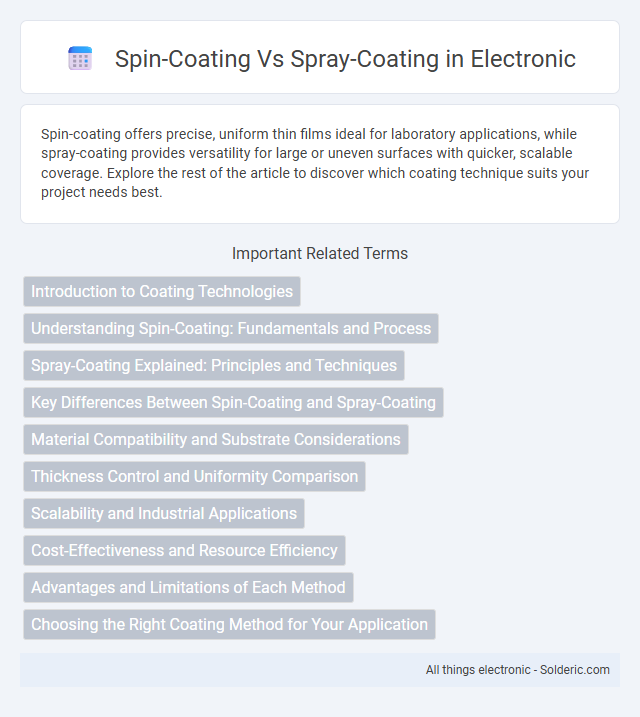Spin-coating offers precise, uniform thin films ideal for laboratory applications, while spray-coating provides versatility for large or uneven surfaces with quicker, scalable coverage. Explore the rest of the article to discover which coating technique suits your project needs best.
Comparison Table
| Characteristic | Spin-Coating | Spray-Coating |
|---|---|---|
| Process | Liquid solution spread by rapid spinning of substrate | Atomized droplets sprayed onto substrate surface |
| Film Uniformity | High uniformity on flat substrates | Moderate uniformity, depends on spray parameters |
| Substrate Type | Best for flat, rigid substrates | Suitable for complex shapes and large areas |
| Thickness Control | Precise control via rotation speed and solution viscosity | Controlled by spray pressure, distance, and time |
| Material Waste | Higher waste due to centrifugal throw-off | Less waste, but potential overspray |
| Equipment Complexity | Simple spinning system | Requires spray gun and compressed air system |
| Applications | Microelectronics, thin films, coatings on wafers | Large-area coatings, conformal layers, polymers |
Introduction to Coating Technologies
Spin-coating and spray-coating are prominent thin film deposition techniques widely used in industries like electronics and optics for applying uniform layers of materials. Spin-coating involves dispensing a solution onto a substrate that spins at high speeds, creating a smooth, consistent thin film ideal for small, flat surfaces. Spray-coating, by contrast, atomizes the coating material into fine droplets sprayed onto substrates of varying shapes and sizes, offering flexibility and scalability for larger or complex surfaces.
Understanding Spin-Coating: Fundamentals and Process
Spin-coating is a precise technique used to apply uniform thin films onto flat substrates by depositing a liquid solution at the center and rapidly rotating the substrate to spread the liquid through centrifugal force. The thickness and uniformity of the coating depend on factors such as spin speed, spin time, and solution viscosity. Your control over these parameters ensures consistent film quality, making spin-coating ideal for applications in semiconductor manufacturing and thin-film optics.
Spray-Coating Explained: Principles and Techniques
Spray-coating applies a fine mist of liquid material to a surface, using high-pressure air or ultrasonic nozzles to atomize the coating solution into droplets for uniform coverage. This technique allows precise control over layer thickness and is effective for complex geometries or large areas, making it ideal for industrial applications such as electronics or automotive finishes. Your choice between spin-coating and spray-coating depends on substrate size, desired coating uniformity, and production scalability.
Key Differences Between Spin-Coating and Spray-Coating
Spin-coating offers precise and uniform thin film deposition by rapidly spinning a substrate, making it ideal for flat, small surfaces in microfabrication. Spray-coating, however, applies material via atomized droplets, suitable for larger, uneven surfaces and scalable industrial applications. Your choice depends on factors like substrate size, film uniformity requirements, and material viscosity, influencing coating quality and process efficiency.
Material Compatibility and Substrate Considerations
Spin-coating excels with uniform thin films on flat, rigid substrates like silicon wafers and glass, ideal for compatible low-viscosity materials such as photoresists and polymers. Spray-coating accommodates diverse substrate geometries, including irregular or flexible surfaces, and supports a wider range of material viscosities, making it suitable for coatings on textiles or curved components. Your choice hinges on the substrate's shape and material properties, ensuring optimal adhesion and film uniformity for the intended application.
Thickness Control and Uniformity Comparison
Spin-coating offers precise thickness control through adjustable spin speed and time, producing ultra-thin, highly uniform films ideal for microelectronics and optics. Spray-coating provides versatility for coating complex surfaces but often results in thicker, less uniform layers due to droplet size variation and overspray. Uniformity in spray-coating can be improved with optimized nozzle design and movement patterns but still generally lags behind the consistency achieved by spin-coating.
Scalability and Industrial Applications
Spin-coating offers precise control over film thickness and uniformity, making it ideal for small-scale research and wafer-level microelectronics but faces limitations in scalability for large or irregular surfaces. Spray-coating provides superior scalability, enabling uniform coatings over large areas and complex geometries, which suits industrial applications like automotive, aerospace, and electronics manufacturing. Your choice depends on production volume and substrate size, with spray-coating preferred for scalable industrial processes and spin-coating favored for high-precision, small-area coatings.
Cost-Effectiveness and Resource Efficiency
Spin-coating offers cost-effectiveness through minimal material waste due to precise deposition on small substrates, while spray-coating can be more resource-intensive with overspray loss yet suits large-area applications reducing overall operational costs. Spin-coating typically requires less solvent consumption and shorter processing times, enhancing resource efficiency for high-precision coatings. Spray-coating's adaptability to diverse surfaces can lower capital expenditure by eliminating the need for substrate-specific equipment, balancing out higher material usage in bulk production.
Advantages and Limitations of Each Method
Spin-coating delivers uniform, thin films ideal for microelectronics and coatings with precise thickness control but struggles with non-flat surfaces and wastes excess material. Spray-coating excels in applying coatings on irregular shapes and large areas efficiently, though it offers less film uniformity and may require multiple passes for thickness control. Choosing between spin-coating and spray-coating depends on substrate geometry, desired film quality, and material conservation priorities.
Choosing the Right Coating Method for Your Application
Spin-coating delivers uniform, thin films ideal for applications requiring precise thickness control, such as semiconductor fabrication and optical coatings. Spray-coating offers versatility with the ability to coat large, uneven surfaces quickly, making it suitable for automotive parts or protective coatings. Your choice depends on substrate geometry, desired film uniformity, and production scale to ensure optimal performance and cost-efficiency.
Spin-Coating vs Spray-Coating Infographic

 solderic.com
solderic.com